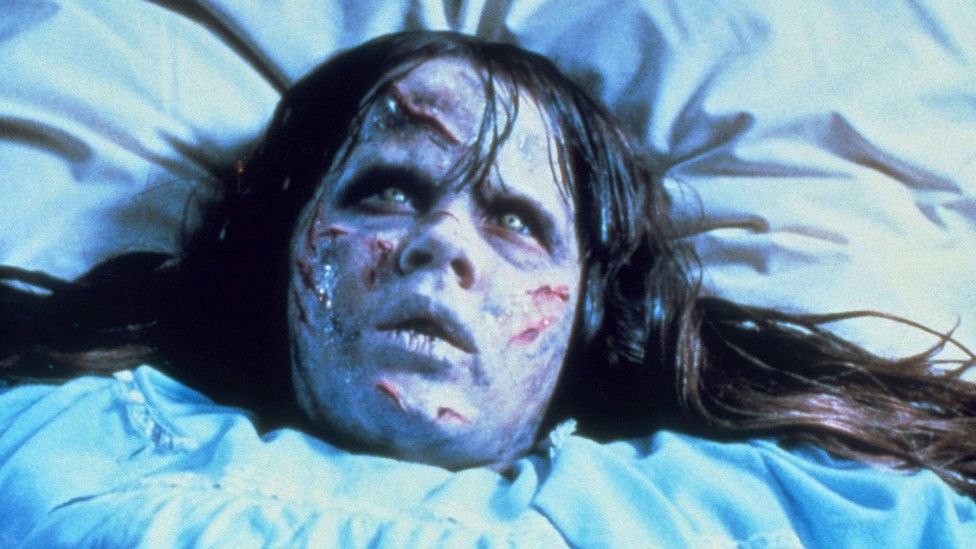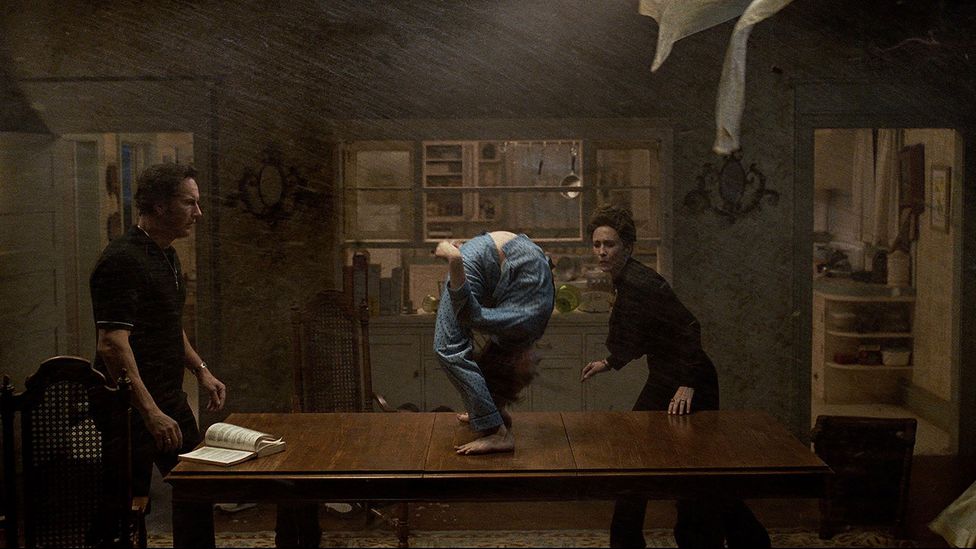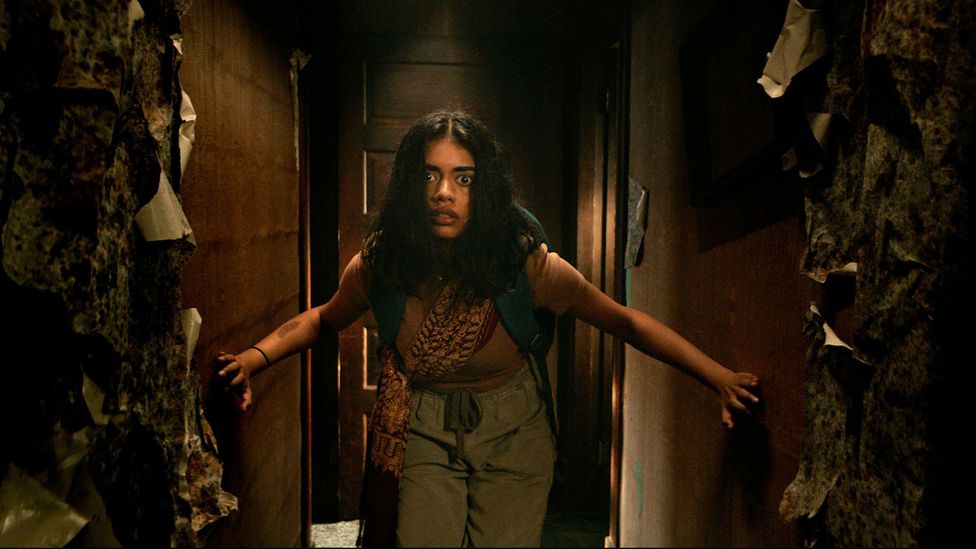Over the last few years, possession narratives, in which characters are taken over by malevolent spirits, demons or gods, have been booming among horror filmmakers, with The Pope’s Exorcism (2023), The Medium (2021), Evil Dead Rise (2022), Umma (2022), Talk to Me (2023), It Lives Inside (2023) and, of course, The Conjuring Universe all deploying them.
More like this:
– The Exorcist reboot is a ‘cheesy rip-off’
– A horror dubbed ‘the number one nasty’
– The 1922 film that still terrifies
Spirit possession as a subject for art is nothing new, and it indeed has even been used as an apparent method for making art, such as by the artists aligned with the spiritualism movement, which hit its peak popularity in the 19th Century. British artist Georgiana Houghton, for example, claimed that she let herself be invaded by spirits, and painted their otherworldly missives. Meanwhile celebrated abstract artists in the late 19th and early 20th Centuries like Wassily Kandinsky, Piet Mondrian and Kazimir Malevich were also interested and influenced by the growing spiritualist movement

The possession of young girl Regan (Linda Blair) in The Exorcist (1973) chimed with 1970s anxieties about the generational divide (Credit: Alamy)
However, when it comes to demonic possession in modern pop culture, there is one ur-text: the late, great William Friedkin’s film The Exorcist, which turns 50 in December. One of the undisputed masterpieces of cinema, horror or otherwise, it is based on the 1971 novel by William Peter Blatty. Like the book, it tells the story of Regan, a young girl in Washington DC who is possessed by a demon and saved by Catholic priests. Alongside its anniversary celebrations, meanwhile, comes this week’s release of David Gordon Green’s The Exorcist: Believer, the latest in a line of legacy sequels (or requels) seeking to restart a powerful horror property afresh (Gordon Green has experience in this area, having previously rebooted the Halloween franchise with great commercial success).
The Exorcist: Believer shares little with its predecessor, bar the name and Hollywood legend Ellen Burstyn’s brief reprisal of her role as Chris MacNeil, the mother of Regan in the original, who is now a celebrated author and exorcism expert. It follows the distraught families of two girls, Angela and Katherine, who dabble with spiritualism and become possessed by an unnamed demon (maybe the franchise’s on-running demon Pazuzu, maybe not). Angela’s father, played by Leslie Odom Jr, carries most of the film, his anguish at the suffering he observes in his daughter mirroring that of Chris watching Regan’s thrashing and suffering.
A truly shocking phenomenon
When it was released in the US in 1973, The Exorcist was more than a film, it was a true cultural phenomenon. Perhaps that was because of the society it was born into, one where religious faith was on the downslide, and there was distrust in a government plagued with scandals like Watergate. There was a collective crisis of faith and an anguished desire to find a culprit, and the devil was as great a scapegoat as any. What’s more, with the advent of the hippie movement of the 60s and early 70s, there was a real cultural divide between generations opening up – so the idea of a young person possessed by dark forces would have resonated with many older audience members who saw their children become alien to them.
“It’s very easy to underestimate how something so novel could capture the zeitgeist,” filmmaker Alexandre O Phillippe, director of Leap of Faith: William Friedkin on The Exorcist (2019) tells BBC Culture. “It’s a film about love, guilt and very powerful human emotions. What do you do when your child becomes possessed by something you do not understand, and you’re helpless in the face of that.”
When the film opened in the US on Boxing Day 1973, there were huge queues of patrons, with one New York Times article reporting that in New York scalpers were selling tickets for $50, and a security guard was receiving offers of $110 (that’s around $768 in today’s money) to skip to the front of the queue. It reported, too, that there had been audience members vomiting, passing out, experiencing convulsions and even, allegedly, suffering a miscarriage.

The Exorcist: Believer (2023) is an attempt to reboot the franchise by director David Gordon Green – this time focusing on two young victims (Credit: Universal)
The release of the film also led to a spate of reports of demonic possession amongst the film’s audience, which Warner Bros cleverly used to drum up publicity for the film. Indeed, the Exorcist’s success helped set the stage for the “satanic panic” of the 1980s, when accusations of satanic ritual abuse swept through the US.
On a cinematic level, the Exorcist’s box-office triumph meant it became a blueprint for a type of demonic possession film that includes most, if not all, of the following ingredients: a glimpse of normality, before the slow build of the transformation as the possession takes hold, a body being attacked from the inside, and an authority figure that saves the possessed (sometimes through an exorcism). Some of the titles that clearly bear The Exorcist’s influence are The Sentinel (1977), Stigmata (1999), The Rite (2011), The Exorcism of Emily Rose (2015) and, again, all The Conjuring films.
The tropes of possession
More than anything, a possession film needs someone to be possessed. Usually, the target is a young girl. “It goes back to the gothic [literature] trope of the hysterical female body,” says Dr Stacey Abbott, professor at the University of Roehampton and co-convener of the recent Horror Reverie: Exorcist Symposium – a body, as Abbott continues, that is “out of control physically, emotionally, sexually and in gothic fiction, this is something they must be ‘saved’ from”. Much like Regan in The Exorcist, the most oft-seen possessed girl is on the cusp of pubescence or a teenager, with their possession a metaphor for the first emergence of desire. Surviving records from the Middle Ages show that possession was associated with punishment for sinful behaviour: virginity had to be protected at all costs.
In most of these demonic possession films, too, it is notably a young white girl who is deemed worthy of protection. A hysterical female body of colour “is traditionally seen as too threatening to be saved”, says Abbott, referencing 1987 supernatural thriller Angel Heart, in which the teenage character Epiphany, played by Lisa Bonet, invites possession through a voodoo ritual: in doing so, says Abbott, “she is too dangerous and cannot survive the film”. The Exorcist: Believer breaks away from this mould by casting dual young female victims of demonic possession, one black, and the other white, although the film fails to address how race plays into the reactions to their ordeal.

The Conjuring films are part of the latest boom in possession stories (Credit: Alamy)
Mary Wild, Freudian horror critic and host of the psychoanalysis and film podcast Projections, points out how few and far between young boys are the victims of possession because “teenage boys and young men are not expected to resist and combat bodily instincts; the prospect of possession in the male context is rendered structurally irrelevant”. On the other hand, blaming female puberty and the emergence of female sexuality on a demonic force is “toxically reassuring”, she says, and absolves the possessed of any responsibility or agency.
Although spirit possession has existed across many religions, from Abrahamic faiths like Judaism, Islam and Christianity, to Hinduism, Buddhism, Haitian Voodoo, Wicca and African traditions, most Western films have taken a Catholic slant on the subject, with victims being saved by the Catholic practice of exorcism.
Distrust in authority is integrated in the DNA of the genre in the form of a lone, protective figure, often a priest at odds with his Church or his own faith (à la Father Karras in the original Exorcist film, or Father Gabriele Amorth in The Pope’s Exorcist). He rejects the guidance of his superiors, breaks the rules and, purporting to have a deeper understanding of the ways of the devil, violently but selflessly extracts the spirit out of the possessed body. In this way, possession movies are uniquely “equipped to remain curious and hold space for social anxieties but also interrogate mass irrationality in a critical way”, says Wild.
Why possession stories are back
If possession narratives are booming once again, that might be because, as in the 1970s, they offer strangely reactionary comforts for a world in crisis, with their suggestion of dark forces beyond human control upsetting the natural order. What’s more, given the ongoing debate around abortion rights in the US and elsewhere, and the pro-choice belief that women’s absolute right to bodily autonomy is under attack, these narratives have an expressly potent resonance right now. A possession is an invasion, after all, a dark power taking over the body of an unwilling host. (Indeed the subject of woman’s bodily autonomy was dealt with in a more literal way in another horror classic from the same era as The Exorcist, 1968’s Rosemary’s Baby).
In more recent horror films, the possession narrative has also evolved in some instances from being about invasion to identity, given that possession inherently presupposes one or more identities fighting for emergence. It Lives Inside (2023) sees an East Indian-American teenager Sam, or Samidha, become threatened by a demonic force that has already possessed her childhood friend.
The film rethinks the possession story away from whiteness and away from the possessed girl needing to be saved by an external authority. Stemming from director Bishal Dutta’s own “dual identity“, It Lives Inside uses its possession story as a vehicle for Sam/Samidha to learn about “their history, themselves, and their relationship to their own diasporic identity”, points out Abbott. Sam is not saved; she is in control. In the film’s conception, the confrontation with the evil spirit is necessary to understand “why it invades us”, says Wild, and “this ‘reprocessing’ approach becomes the mechanism of liberating (exorcising) the body of the upsetting haunting element”.

It Lives Inside (2023) uses possession as a metaphor to explore dual identity (Credit: Alamy)
Possession is such a terrifying concept because it involves a total loss of control and a corruption of what it is to be human. Possession films play with perspective, choosing between emphasising the internal struggle of the possessed or the distress of the people at a loss with a possessed loved one. In Evil Dead Rise (2023), we see a loving mother being possessed by a ravenous, demonic spirit, and attacking her children; in The Exorcist, Reagan’s plight is seen mostly through the eyes of her mother Chris, who helplessly watches a parade of doctors prick and prod at her daughter without offering any solution. The same occurs in The Exorcist: Believer, which spends most of its time with the possessed girl’s parents, rather than the possessees themselves.
Phillippe ponders that “the consciousness of being taken over by something you don’t understand is a really terrifying thing and is really similar to death”. It is a fear that is consistently reinterpreted and assuaged by horror movies, who offer a happy ending to the possessed girls and boys.